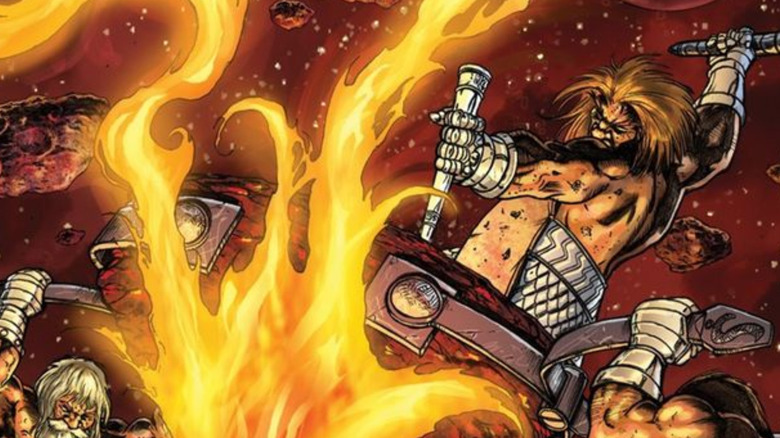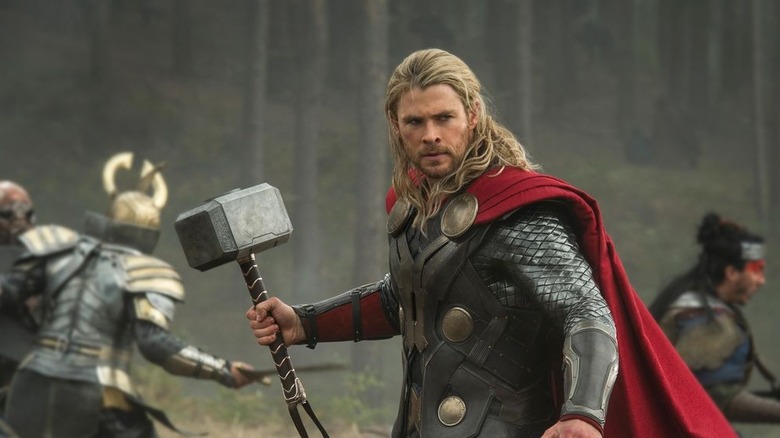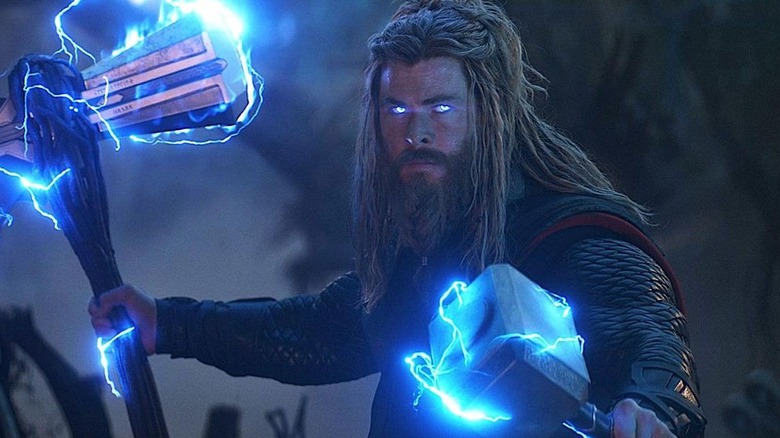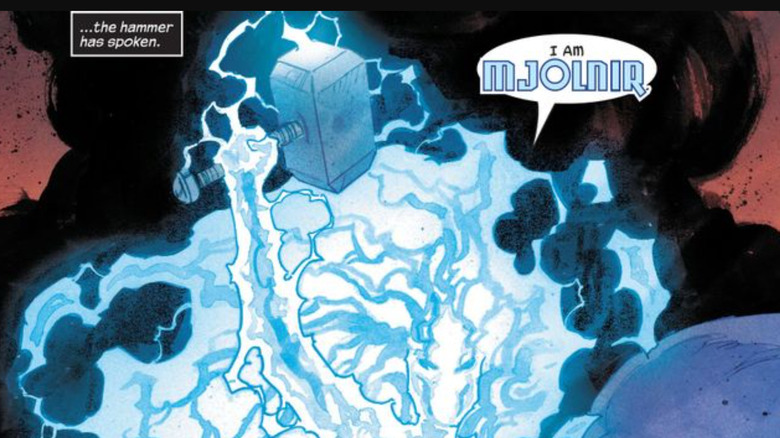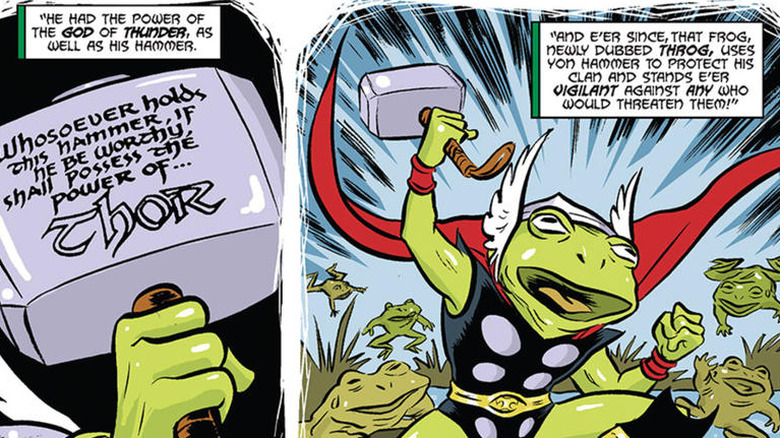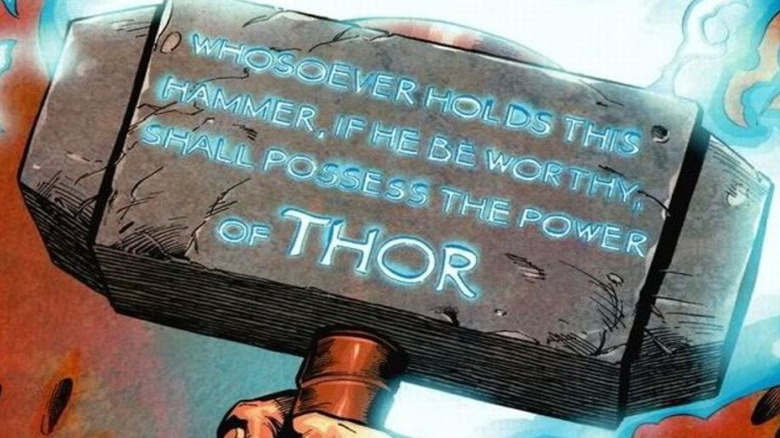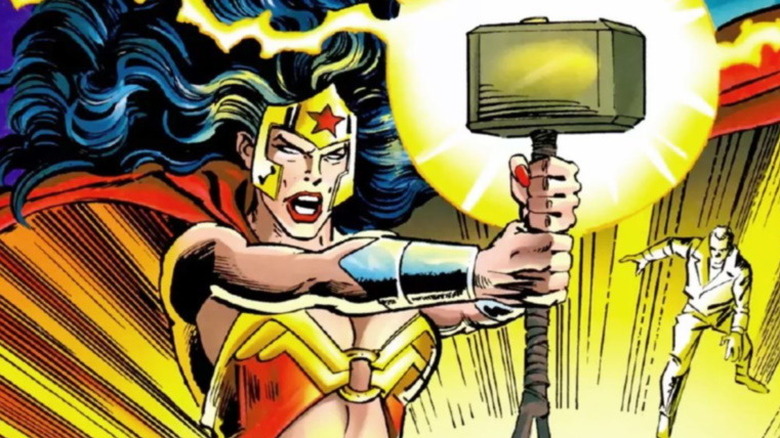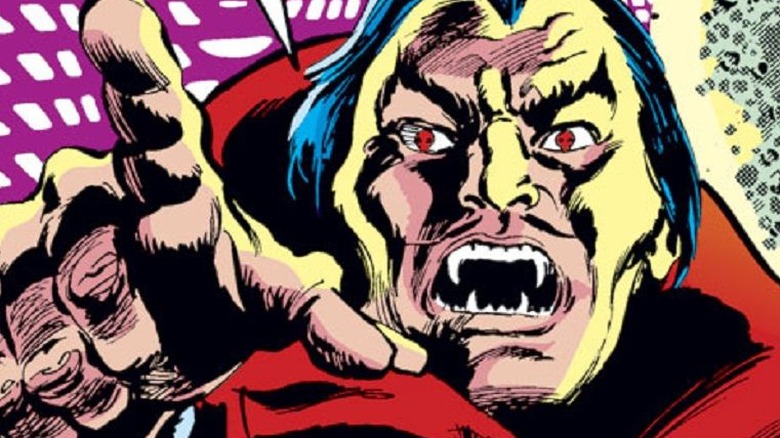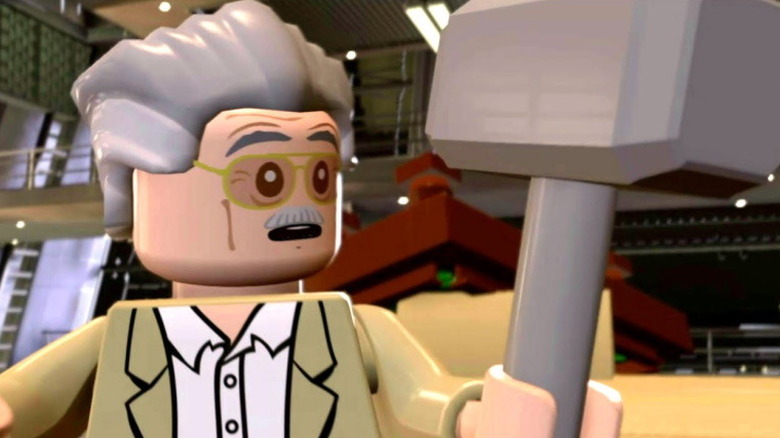The Untold Truth Of Thor's Hammer Mjolnir
Name a more iconic duo than Thor and his hammer, Mjolnir. The Norse god of thunder and his trademark weapon have been bashing baddies since before the Viking era. In modern times, the two are most associated with their iteration in Marvel Comics and the Marvel Cinematic Universe. In those worlds, Thor is not just a god, but a living and breathing hero with flaws whose origins, while quite different, serve as the inspiration for the Norse myths.
Few superhero weapons go together better than the Norse god of thunder Thor and his mighty hammer Mjolnir. While Iron Man's armored suit boasts plenty of exotic weaponry and Batman's batarangs are definitely versatile; even today, Mjolnir remains one of the most powerful, cutting-edge weapons in Marvel Comics and the MCU, possessing enough power to destroy a planet.
But what do you truly know about Mjolnir's abilities and centuries-long history? From the reason why Mjolnir has such a short handle to its gruesome effect on vampires to what Chris Hemsworth does with hammers when nobody's looking, here are the most fascinating facts about Thor's hammer, Mjolnir.
Mjolnir's handle is short for a reason
One of Mjolnir's most distinctive features is its short handle. While this feature of the weapon is taken at face value by both the comics and the films, there's a lot more to Mjolnir's length than you might expect. The story behind Mjolnir's creation, as well as its unique appearance, goes as far back as the original Norse myths, where Loki's penchant for mischief continues to make everything worse (via Mythology.net).
In the midst of a much larger tale about Loki stealing the hair of Thor's wife, Sif, Loki commissions two dwarfs named Brokkr and Sindri to create three magical gifts for the gods. To up the stakes, Loki bets his head that the two couldn't make gifts as good as those of Ivaldi, who made Sif's replacement hair. To ensure that he keeps his head, Loki transforms into a fly and bites Sindri while he makes Mjolnir, resulting in the hammer coming out with a shorter handle than intended. Despite its top-heavy appearance, it was still mighty and (as Vision said) "terribly well balanced," and thus the mythological Thor cherished it just as well.
While the mythological origins of Mjolnir weren't carried over into Marvel, with the comic version being crafted out of Uru metal in a dying star, it is interesting to see how it influenced the comic's design (via Marvel Database).
Chris Hemsworth loves stealing hammer props
Many people may not be able to pronounce "Mjolnir" correctly (least of all being Paul Rudd), but you'd be hard-pressed to find someone who thinks that the hammer isn't exceedingly cool. It's right up there with Captain America's shield, Batman's batarangs, and Wonder Woman's Lasso of Truth as one of the most iconic weapons in superhero history. Of course, Thor himself (i.e., Chris Hemsworth) is not an exception to this rule. As it turns out, the awesome Australian is an avid hammer thief while on set and has "about five" of them at home.
"One's ... next to the toilet if you need some assistance with that for whatever reason," Hemsworth said in an interview with Jimmy Kimmel. Keep in mind, actors generally aren't allowed to take props home from film sets. Oftentimes, when you hear of an actor keeping a prop, it's technically because they stole it. The case of Thor's hammer is no different, meaning that Hemsworth has stolen five likely valuable props right out from under Marvel's nose (at least one of which is being used as a toilet paper holder), and we love him for it.
Captain America isn't the only worthy one
It was a major moment in "Avengers: Endgame" when fans finally saw Captain America (Chris Evans) wield Mjolnir, proving once and for all that he truly is worthy of the power of Thor. It was a plot moment that was multiple movies in the making, with Cap's worthiness being teased way back at the beginning of "Avengers: Age of Ultron." However, as many Marvel megafans already know, Captain America is far from the only superhero worthy of wielding the hammer.
Aside from Cap and Vision, who briefly wielded the hammer in "Age of Ultron," the Marvel Database actually lists dozens of characters who are able to hold Mjolnir. These include other Asgardians like Odin and Bor, familiar characters like Jane Foster and Black Panther, and even up-and-comers like Moon Knight, who is gearing up for his own Disney+ exclusive series starring Oscar Isaac.
Those unfamiliar with Moon Knight's lore might be confused as to how a somewhat unhinged vigilante with multiple personalities could be worthy of Thor's hammer. However, thanks to Khonshu's (the ancient Egyptian god whom Moon Knight serves) status as a moon deity, Moon Knight can hold and even control Mjolnir because Uru is technically made of moon rock (via ComicBook). This could be an interesting plot point in the near future if we ever see the MCU reforge Mjolnir while Moon Knight is around.
It has plenty of seldom-used powers
Lightning, flying, and hitting things really hard are the powers most people would associate with Mjolnir. However, Mjolnir is capable of much more than summoning lightning and smashing bad guys. Much like how Superman once had an abundant list of odd powers that he no longer uses (via DC Comics), Mjolnir has a similar penchant for doing whatever the writer needs it to at that moment.
Just to name a few examples of this, Mjolnir can open wormholes to instantly travel across the universe, turn Thor invisible, manipulate people's souls, translate everything Thor says into any language he needs, and sense energy signatures. Of course, none of those powers quite replace bonking people on the head and shooting them with lightning in most situations, which is why you still primarily see Thor using those abilities in battle.
Nevertheless, it's important to remember that Mjolnir is still one of the most powerful and versatile weapons in the universe. Therefore, Thor is likely much more versatile than most comics and MCU fans would give him credit for. He's certainly more than just a hunk of muscle and lightning.
The hammer is a god too
A lot has happened to both Thor and Mjolnir in recent comics. From becoming unworthy and allowing the mantle of Thor to be carried by Jane Foster to seeing Jane sacrifice both herself and the hammer to stop the hate-fueled being Mangog to finally reforging the hammer so that Thor could fight the elf Malekith in the War of the Realms, Mjolnir has seen a lot of change. What nobody ever expected, however, was for the hammer to wake up.
Of course, Mjolnir had always been somewhat alive. Part of its comic-book origin is that Odin trapped the God Tempest in the Uru that would become Mjolnir. Upon being reforged, however, the God Tempest's essence combined with that of Mangog, a being who despised Asgard for the genocide of its people (via Marvel Database). Thus, Mjolnir was able to create its own avatar, one that no longer cared for Thor or Asgard and only desired death and destruction, dubbing itself the "God of Hammers" ("Thor" Vol. 6 #19).
Unfortunately, the comics have not shown what happens next as Thor and his Asgardian family confront this new and deadly foe. With powers equal to (or greater than) those of Thor himself, there's no telling what could happen to the hammer. It could get destroyed again or return to the fold as Thor's weapon. These events could even go on to inspire the MCU, allowing Mjolnir to return even from its destruction in "Thor: Ragnarok."
Mjolnir can create copies of itself
Mjolnir showed some cool new abilities in "Thor: Love & Thunder," including the power to reassemble itself from its shattered Uru metal shards — and then temporarily disassemble itself again to attack an enemy from all directions. But did you know those pieces of Mjolnir can become entirely new hammers in the comics?
This came in handy for Puddlegulp, one of Thor's more unusual friends, who first appeared in "Thor" #364. Once a man by the name of Simon Walterson who was transformed into a frog by a curse, "Puddlegulp" was adopted by New York's secret frog kingdom and fought against a rival rat army alongside Thor when the Thunder God was transformed into a frog by Loki. Simon/Puddlegulp revealed his true identity to Thor and watched as the Frog of Thunder lifted Mjolnir, transforming into a giant frog in Thor's armor.
Unknown to Thor, a sliver of Mjolnir had broken off the hammer, and when Puddlegulp proved worthy enough to lift the shard of Uru metal, it transformed into the mighty Frogjolnir and turned the enchanted frog into ... Throg, Frog of Thunder (yes, really).
Throg used his Asgardian powers to protect the frogs of Central Park and eventually went on to team up with other animal superhero sidekicks to form "The Pet Avengers" (basically Marvel's answer to DC's League of Super-Pets). Weird as this story might sound, if Mjolnir really is a sentient being, it stands to reason that it can reproduce and make new enchanted hammers for the worthy. Including frogs.
Mjolnir has many possible translations
Fans have been struggling with the proper pronunciation of "Mjolnir" for decades (for the record, it's "Me-yol-neer"). Once you accomplish this, however, an even more relevant question comes up. What exactly does "Mjolnir" actually mean?
Even historical linguists have been struggling to answer this. According to the website Norse Mythology for Smart People, most scholars trace the name "Mjöllnir" back to the Old Slavic word mlunuji, the Russian word molnija, and the Welsh term melt, which all translate into the word "lightning." As Thor's own name goes back to a Proto-Germanic root meaning "Thunder," this seems appropriate.
However, some scholars also point out that "Mjolnir" may be related to the Icelandic words mjöll, (or "new snow") and mjalli (or "white"), both symbols of purity. This could relate to the way Thor's hammer was often used in rituals for consecrating (such as marriage), effectively purifying those it blessed.
The website Symbolsage also notes the term Mjolnir may be derived from the Proto-Germanic word meldunjaz, which translates into "to grind." This could mean Mjolnir was known as "the grinder" or "the crusher" — two things it's still known for doing today in the Marvel Universe.
Marvel's Mjolnir gave two DC icons a special bond
Thor variants show up in multiple fictional universes, and DC Comics has its own Thor who wields his own mighty hammer. However, it's actually Marvel's version of Mjolnir that caused two DC icons — Superman and Wonder Woman — to share a special bond.
Superman got to wield Mjolnir in the DC/Marvel crossover miniseries "Avengers/JLA" by writer Kurt Busiek and artist George Perez. The story saw Marvel's Avengers and DC's Justice League come to blows and eventually team-up to save their universes from mutual destruction. In the final battle, Thor passed his hammer to Superman, who found his power magnified beyond imagination by Mjolnir's magic. Curiously, the Man of Steel found he could no longer lift the hammer following the battle, although Thor assured him Mjolnir was in good hands for the brief time he wielded it.
Wonder Woman found herself worthy to lift Mjolnir in the "DC vs. Marvel" crossover event by Ron Marz, Peter David, Dan Jurgens, and Claudio Castellini when she came across it following Thor's battle with Captain Marvel/Shazam. Although the hammer increased Wonder Woman's power to insane levels, Diana decided to fight without it when she was matched up with Storm, feeling Mjolnir's magic would give her an unfair advantage. Later, she politely handed the hammer back to a perplexed Thor.
Although these crossover events would fade in and out of memory, both Superman and Wonder Woman are remembered as worthy wielders of Mjolnir in "Thor: The Worthy" #1 by Kathryn Immonen, Tom Reilly, Chris O'Halloran, and VC's Clayton Cowles when Jane Foster's Thor glimpses the Man of Steel and Amazon Princess among the worthy. Superman himself indicates he recalls these events in "Superman" #165 when he gives Diana a gold pendant shaped like Mjolnir as a Christmas gift, recognizing their unique bond.
Vampires fear Mjolnir for a very good reason
Mjolnir is a mighty weapon — but some fans forget that it's also something far more. Since the Asgardians were once worshipped as gods, Mjolnir is considered a religious item, meaning it is particularly dangerous against supernatural entities like vampires and the undead.
In "Thor" #332, fans see just why vampires should be afraid of Mjolnir, when Thor goes up against some bloodsucking fiends serving Dracula. Upon seeing a vampire attack a woman, Thor throws his hammer at him, causing the creature to burst into flame and transform into dust the second Mjolnir touches him. The hammer proves equally effective when Thor dusts some giant vampire bats a few panels later. Unfortunately, when Thor attempts to use Mjolnir against Dracula himself in the next issue, the vampire lord gets teleported away.
Notably, religious relics only work against the undead if wielded by someone who believes in their power (which is why crucifixes don't always work against vampires). Since Asgardians aren't worshipped the way they used to be, this limits the hammer's effectiveness as a vampire weapon. However, Thor's special relationship with Mjolnir provides him with all the belief he needs, meaning the Thunder God may be one of Marvel's most powerful vampire hunters. Sorry, Blade.
Stan Lee used Mjolnir to give Thor a more realistic flight power
As is the case with a lot of godlike superheroes, Thor possesses the power of flight. Unlike Superman or Wonder Woman, however, the God of Thunder has a very specific means of getting airborne — he spins Mjolnir really fast and then launches it skyward, using its forward momentum to pull him into the air.
As it turns out, this unique means of "flight" was devised by Stan Lee to get around what he saw as a common fallacy among flying superheroes — they had no visible means of propulsion. In one of his videos for "Stan's Rants," Lee revealed that when Thor wants to fly "we use a scientific principle," raving about how his use of "hammer propulsion" provided a scientifically sound explanation for Thor's flight.
Over the years, however, various artists like Jack Kirby and Oscar Jimenez have shown Thor flying without Mjolnir in Superman-type poses, calling into question whether Thor actually needs his hammer to fly. Nevertheless, science writer Kyle Hill proposes in his "Scientific American" article "The God of Thunder, and Momentum," that Mjolnir could conceivably drag a much lighter Thor through space if it made itself incredibly heavy (something that also explains how Mjolnir could keep the unworthy from lifting it). Who knew Stan Lee was such a science genius?

